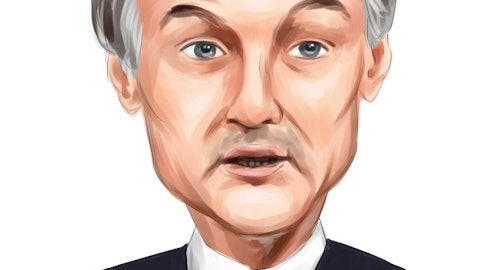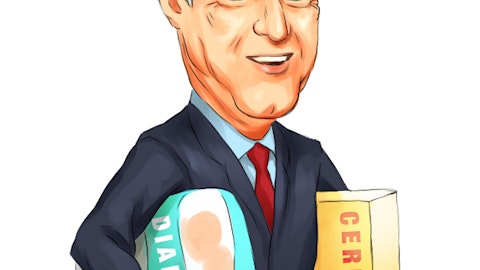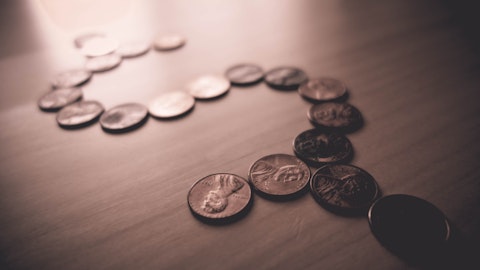Diebold Nixdorf, Incorporated (NYSE:DBD) Q4 2023 Earnings Call Transcript February 14, 2024
Diebold Nixdorf, Incorporated beats earnings expectations. Reported EPS is $3.02, expectations were $1.39. DBD isn’t one of the 30 most popular stocks among hedge funds at the end of the third quarter (see the details here).
Operator: Hello, and welcome to the Q4 2023 Diebold Nixdorf Earnings Call. My name is Alex. I’ll be coordinating the call today. [Operator Instructions] l’ll now hand it over to your host, Christopher Sikora to begin. Please go ahead.
Christopher Sikora: Hello, everyone, and welcome to our fourth quarter and full year 2023 earnings call. To accompany our prepared remarks, we have posted our slide presentation to the Investor Relations section of our corporate website. Before we begin, I will remind all participants that during this call, you will hear forward-looking statements. These statements reflect the expectations and beliefs of our management team at the time of this call, but they are subject to risks that could cause actual results to differ materially from these statements. Additional information on these factors can be found in the company’s periodic and annual filings with the SEC. Participants should be mindful that subsequent events may render this information to be out of date.
We will also be discussing certain non-GAAP financial measures on today’s call. As noted on Slide 3, a reconciliation between GAAP and non-GAAP measures can be found in the supplemental schedules of the presentation. With that, I’ll turn the call over to Octavio.
Octavio Marquez: Thank you, Chris, and thank you all for joining us. To get things started today, I wanted to give our Chair, Pat Byrne, another opportunity to share some opening remarks. Pat and the broader Board have been in place for about four months now. We have spent that time working closely together to establish our governance framework and align around longer-term objectives for the company. So today, I thought it would again be appropriate for Pat to kick us off with some of his early takeaways working with Diebold Nixdorf. Afterwards, Jim and I will walk you through our quarterly results. Pat, over to you.
Pat Byrne: Thanks, Octavio. I’ll just make a few comments to provide an update on the Board progress and give you a sense of our excitement for the future of Diebold. We’ve been working together as a new Board of Directors for several months now and are making very good progress as we completed fiscal year 2023 and set priorities and objectives for fiscal 2024. We’re also building strong governance and board oversight and the Board and management team are working well together, focused on running the company towards consistent and improving operating results while also building a flywheel that leads to accelerating profitable growth, margin expansion and free cash flow conversion. Octavio and his team are entering 2024 with real momentum and with clear priorities of both operations and multi-year transformation agenda.
As I mentioned last quarter, we believe that the Diebold market position in both banking and retail built on strong customer relationships and innovative technology puts us in a strong position to win in the marketplace going forward. We’re confident in our 2024 guidance and the long-term outlook for the company. We intend to share our views of the market, the Diebold opportunities and our long-term plans and targets in a 2024 Investor Day. We’re currently planning on doing this Investor Day in the middle of the year, and we’ll keep you updated on our plans. We’re excited about the future of Diebold and working closely with Octavio and his team to drive long-term shareholder value. Now I’ll turn it over to Octavio and to Jim.
Octavio Marquez: Thank you, Pat. We appreciate you being with us and sharing your thoughts today. We are looking forward to continue working with you and the Board on the journey ahead. So, now starting on Slide 4. We have highlighted four areas that summarize our positive results in the fourth quarter. First, we continue winning in the market with our leading self-service and automation technology. Our customers are continually striving to improve customer experience and lower operational costs. We are seeing consistent installed base refresh activity as customers are increasingly replacing legacy solutions with our new technology. Demand remains high for our ATM cash recycling and retail self-checkout solutions, which are also establishing recurring service revenue and additional software business with a high attach rate.
We remain focused on driving innovation that our customers need. The team introduced our AI-powered Vynamic Smart Vision Shrink Reduction Solution as we build on our Retail self-checkout technology deployed in the market. This solution addresses shrink-related challenges in retail using AI and computer vision technology to reduce loss during checkout. On the banking side, our teller cash recycler has started shipping in North America. DN’s in-branch cash recycling solution supports end-to-end automation across the entire cash ecosystem at the branch from ATMs to the teller line. We continue to view branch automation as a meaningful growth opportunity. With over 70,000 bank branches in the U.S. alone, and the consistent drive by banks to reduce operating expenses, we know this offering meets the needs of our customers.
Once again, we had another quarter of strong performance as our team remained focused on customers and continued to improve our operational execution. The team can be proud that in each quarter of 2023, we grew revenue and profitability on a year-over-year basis. Our improved operational execution helped us meet expectations for the year and position us well moving into 2024. Lastly, we achieved another milestone by paying down $200 million of our higher cost term loan and securing a new revolving credit facility. This will provide us with the flexibility we need to manage the seasonality of our business at a lower cost. In addition, we were able to do this because we generated fourth quarter free cash flow of $150 million and ended the year with more than $600 million in cash and short-term investments on our balance sheet.
Turning to Slide 5, I want to highlight regional trends. We operate a balanced global business, and each of our regions contributed to revenue growth in 2022. In North America, we continue to see strong adoption of cash recycling technology driving our banking business as well as more retail wins with our self-checkout solution in the quick service restaurant space. We see additional runway for both these offerings in North America and expect it to be a significant part of our growth story going forward. Additionally, we continue to focus on customer service and quality with higher investment in our service business. In Latin America, cash usage remains strong, supporting demand for both our DN Series cash dispensers and cash recyclers. Growth in Latin America service revenue was a bright spot in 2023 as we continue benefiting from a growing installed base in the region.
In Europe, we continue to see an overall stable market for banking. In retail, most of our self-checkout shipments represent new placements in the market. This has helped grow our installed base and supports our recurring service business. In Asia Pacific, Middle East and Africa, we are seeing broad growth with our products across the entire region, with strength in the Middle East and Africa. We also ended the year on a strong note in India, as we delivered about 5,000 units in country after reentering that market with local manufacturing presence in 2023. Now to our full year financial performance on Slide 6. Throughout the year, we delivered significantly improved performance by profitably growing revenue, expanding gross margin and driving cost discipline.
This focus is clearly evident in our performance with total revenue up 9%, gross margin expansion of 160 basis points and operating expenses down 2% compared to prior year. Resulting in operating profit growing approximately 75%. Full year adjusted EBITDA of $401 million is up 43% compared to prior year and adjusted EBITDA margin expanded 300 basis points to 10.7%. We finished the year in line with our expectations and at the high end of our previously communicated outlook range. While I am pleased with our 2023 performance, which demonstrates that we are taking the right steps, we know that we can build upon this and further improve in 2024. With that, I will hand the call over to Jim.
Jim Barna: Thank you, Octavio. Starting on Slide 7, the fourth quarter was another period of continued improvement that was in line with our expectations. Revenue and profitability were up significantly both sequentially and compared to the prior year. The higher revenue with gross margin expansion is flowing through to the bottom line, resulting in strong year-over-year growth in operating profit and adjusted EBITDA. Revenue of $1.04 billion increased 7.6% and gross margin expanded 340 basis points year-over-year. Strong product performance was the primary driver behind the gross margin expansion as we continue to drive benefit from our improved supply chain and pricing discipline. Q4 2023 operating expense was up compared to the prior year period.
However, note that the prior year period included a nonrecurring adjustment that reduced variable compensation. If not for that adjustment, operating expenses would have been flat year-over-year. Looking at free cash flow, please note in the prior year period, product deferred revenue was elevated relative to historical levels and has now been normalized. Q4 2023 free cash flow of $150 million was up $66 million year-over-year, driven by favorable EBITDA performance, better working capital efficiency and meaningfully lower interest. Turning to Slide 8, banking revenue of $750 million was up approximately 9% versus the prior year period, driven by product revenue growth of 19%. Approximately half of the growth came from higher volume with the other half driven primarily by pricing and mix with a small currency benefit.
We continue to have consistent demand for our DN Series offering, and improved supply chain and logistics conditions have enabled us to deliver on this demand. Service revenue was up approximately 1% versus the prior year, driven by higher product installation revenue. As a reminder, ATM deliveries across the industry mostly represent replacement units in the market. So the high product installation activity we saw in the quarter should lead to a stable installed base going forward. Banking gross profit in the fourth quarter increased by $46 million year-over-year to $202 million. This resulted in banking gross margin of 27% in the quarter, which is up 430 basis points year-over-year. Significant gross margin expansion was due to the continuation of price increase realization, greater input cost control and higher production volume in the quarter.
Moving to Slide 9. Retail revenue of $288 million was up 4.5% versus the prior year as we continue to see strong service activity with new placements of self-service units driving higher contract revenue. Solid growth in scope product revenue was offset by lower ePOS revenue as retailers continue to transition towards higher value self-checkout solutions. Retail gross profit in the fourth quarter increased year-over-year to $74 million. This resulted in retail gross margin of 25.6% in the quarter, which is up 100 basis points compared to the prior year driven mostly by product gross margin expansion from a favorable mix of higher SCO units. On Slide 10, this is a more complete view of the changes in our cash position over the last five quarters that we wanted to share today, which is aligned to how we manage the business.
In the past, we have had significant quarterly volatility in our free cash flow. Aside from the impacts related to the financial restructuring in 2023, these swings have historically been driven by a number of factors, including seasonality in our earnings, a working capital cycle that historically resulted in significant cash use through the first three quarters of the year and payments related to restructuring and transformation efforts. We believe that exiting 2023, we are now in a better position to more efficiently manage free cash flow and purge some of the historical volatility that has been present in our performance through improved commercial and operating rigor. Going forward, we will deliver meaningfully better free cash flow conversion as we manage working capital more efficiently, lower cash interest payments and manage cash spent on restructuring and transformation initiatives with a strong focus on returns.
As Octavio mentioned in his opening, we paid down $200 million on our term-loan and secured a revolving credit facility, which should result in approximately $15 million of savings in annual net interest. This is just the beginning of the improvements we expect to realize as we believe we have many opportunities ahead of us to show continuous improvement. Again, free cash flow was a source of $150 million in the quarter, which is up $66 million compared to the prior year period. And it is our expectation in each quarter of 2024 to show year-over-year improvement in free cash flow. On Slide 11, turning to our outlook for 2024, we expect to profitably grow revenue in the low-single digit range. We consider this to be a more normalized revenue growth rate for the company going forward, and we feel good about hitting this target due to our backlog visibility and recurring nature of service and software revenue.
We expect adjusted EBITDA to be in a range of $410 million to $435 million, which is benefiting from continued gross margin expansion and disciplined operating expense control. Looking at the quarterly cadence for the year, we expect the split between the first half of the year and second half of the year to be approximately 40% versus 60%, which reflects an initial improvement in our efforts to more linearize the year compared to 2023. Lastly, the outlook contemplates free cash flow conversion of greater than 25%. As I mentioned, we plan to execute on working capital improvements, and we’ll continue to opportunistically lower debt costs, all while growing EBITDA and expanding margin to generate higher free cash flow conversion. To close my remarks, we are entering 2024 with improved operating momentum and are well positioned as we work to deliver on our outlook.
Now I will turn the call back to Octavio.
Octavio Marquez: Thanks, Jim. Wrapping things up on Slide 12. Let me walk you through an early view of our continuous improvement in churn. It all starts with our people, who make Diebold Nixdorf a great company. We are taking a fresh perspective with several initiatives planned to reinforce that we’re a people-first organization. We will empower our teams to drive continuous improvement through trust, transparency and a shared commitment to excellence. The company strives to attract, develop and retain exceptional people. As a result, a strong team will deliver profitable revenue growth, winning new customers and increasing wallet share through crisp, commercial execution. In addition, we will accelerate growth through focused innovation for our customers by executing on our R&D pipeline to maintain our technology leadership.
We will continue expanding margin while exceeding customer expectations. Accelerating the adoption of remote diagnostic and resolution, simplifying our product set to reduce component costs and complexity and implementing an industry-leading operating expense profile will drive improve profitability. Finally, we will execute on the levers that Jim outlined earlier to improve free cash flow conversion. Improving quarterly linearity will continue to be an area of focus. These four components help us build the flywheel for our growth and continuous improvement and will help us better visualize and achieve our longer-term objectives. As we conclude our prepared remarks, I am excited about the future of Diebold Nixdorf as we start our continuous improvement journey.
I look forward to sharing more with you throughout the year as we achieve these objectives. Lastly, I wish to thank our customers for their ongoing support. We are committed to providing best-in-class solutions to help them achieve positive business outcomes. And I remain incredibly proud of our Diebold Nixdorf employees around the world. Our team continues to focus on what is the most important, our customers all while improving operational execution. And with that, operator, please open the call for Jim and me to take questions.
See also 10 Largest Cruise Ships in The World and 24 Best Countries to Live and Work in 2024.
Q&A Session
Follow Diebold Nixdorf Inc (NYSE:DBD)
Follow Diebold Nixdorf Inc (NYSE:DBD)
Operator: Thank you. [Operator Instructions] Our first question for today comes from Matt Summerville of D.A. Davidson. Your line is now open. Please go ahead.
Matt Summerville: Thanks. Excuse me, a couple of questions. You talked a little bit about product gross margins in the prepared remarks. I’m curious, a couple of things that absolute level at 25.5%, realizing their seasonality to the business, how sustainable is that relative trend in improvement? Is there still incremental price capture to be had as you’re driving down, I would expect, driving down backlog over the course of the year? And then you didn’t address services gross margins those headed in the wrong direction? So talk a bit about that. And then I have a follow-up. Thank you.
Octavio Marquez: Thank you, Matt. So let me start with product. So we continue to see very, very strong demand for both our DN Series recyclers, our DN Series self-checkout solutions. So we’re – I think that that’s the good news. Technology is being adopted by customers, customers like the product set and they continue investing in it. You’re right, there’s a certain level of seasonality in our business. So you might see slight variations in our gross margin quarter-over-quarter. But I would tell you that our intention is to keep the trend that we’ve been on, which is continue improving our overall gross margins. Even though we made significant progress in our supply chain and our efficiency, we’re just at the beginning of our journey.
I’m super excited as we announced a few weeks ago, we’ve hired a new operating excellence leader for the company, Frank Baur, who will help us in this journey and continue accelerating the improvement in all our operations, and that leads me to service. Our service business, and this is very important to me is a people-driven business. So we need to make sure that we’re delivering the highest quality for our customers and that we’re creating an environment where all our people can thrive and be successful. So in Q4 and as we manage the portfolio of hardware, software, services creating the solutions that we have, we’ve invested heavily in our service infrastructure, particularly in North America. So we’re battling some of the secular trends around the difficulty of hiring people, the difficulty of retaining people.
But in this balance, we want to make sure that as we’re battling those things, we’re keeping the customer at the center of our actions and making sure we delivered excellent service to them. So our goal is we will continue working on improving our service margins. It’s clearly an area of opportunity for the company. We’re all aware of it. And we want to do that while we continue to improve our service. So our commitment for the year is to getting back to our historical service margin levels as the year progresses, but doing that in a way that we continue serving our customers with excellence.
Matt Summerville: Thank you for that. And then I just – what’s your view just for the market overall? I know Diebold is not going to disclose units anymore. But if we think about just the global ATM market, the global self-checkout market, what do you expect in terms of unit growth roughly in 2024 relative to 2023? And how do you think about Diebold going forward in terms of your ability to reduce Diebold’s reliance on hardware cycles? Thank you.
Octavio Marquez: So let me start with self-checkout this time as retail is a very important business for us. So Matt, I think, there is no doubt that consumer preferences keep shifting and the ability to offer options that self-checkout, whether its assisted self-checkout, self-checkout continues to be important. And there’s, as I mentioned, new technologies that we keep adding to the self-checkout process to make that a frictionless thing both for our retailers and for the consumers of our retailers, so really changing the way people shop and the experience at the self-checkout. So we can – we see this market to be one of continuous growth. There is no – whether it’s labor, whether it’s customer experience, self-checkout helps improve that.
So we continue to see that market as growing at a very healthy clip. Remember, we’ve been traditionally a small provider, even though now we’ve gained significant share or at least that’s what we believe will happen when the analyst’s report these things. Remember, or as I mentioned in our remarks, every self-checkout that we deploy is basically a new placement for us, or has been for the past year. So we’re growing and gaining that market and we see that market as continuing to expand. On the banking side, and again, that’s why I tried – I know you like this question around the markets. That’s why I tried to add to the regional color now. It’s a varied business. There is clearly mature markets that are growing at a slower rate. There is some markets that are growing at a faster rate.
I would say, overall, I would characterize the market as one that is stable and growing a couple percentage points one year probably shrinking a couple percentage points the other year. So what’s important about this market is the shift that is happening towards higher-value products like recyclers that provide significant value for customers. And what’s also important is that we view that when you think of the cash ecosystem at the branch level, you can’t only just think about the ATM. You need to think about the teller line. As banks think of a different way to serve customers, it’s all about this cash ecosystem in the branch. And we’ve now entered with our teller cash recycler into this market. So that should help us accelerate a little bit of the growth that we – that probably a flattish ATM market won’t provide in the coming years.





